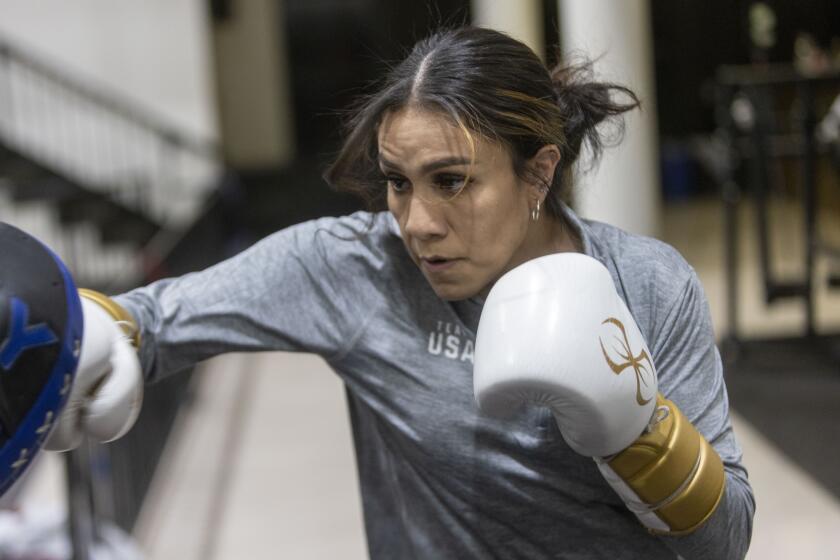Let the standing count begin
So, the recent news comes that Oscar De La Hoya apparently will keep on punching. And being punched.
We had hoped for better.
We had hoped that, in a sport in which everybody says they are going to retire and nobody does, De La Hoya would rise above the crowd.
We had hoped that, in a sport in which the big money comes and the big money goes, but the most common payoff is brain damage, De La Hoya would rise above the crowd.
Part of this is personal.
We like De La Hoya and have spent more time with him than you normally get with a superstar athlete. If he gets hurt, it is not like it will be somebody you watched from the second row of the first balcony.
We sat alone with him for about half an hour after his first loss, to Felix Trinidad, and saw the pain and frustration. We have watched him handle himself through major victories and tough losses. He has matured, acquired a sense for his place in boxing history. He has a sense for maintaining a public image consistent with somebody whose nickname is Golden Boy.
Part of this is logic.
He is a multimillionaire with a great business future. He and partner Richard Schaefer promote fights, buy buildings, invest for growth and give back to the community with athletic facilities and youth centers.
Since Trinidad in 1999, De La Hoya has lost four of 11 fights and yet has lost little in terms of image and earning power. In May, when Floyd Mayweather beat him on a split decision, De La Hoya handled it with class, came out of the fight with no apparent injuries and won a reported $45 million.
It was his 43rd professional fight, to go with 228 amateur fights. No matter what anybody says, that’s a lot of hitting and being hit, especially when the brunt of damage to boxers is done by sparring partners, not fight-night opponents. He will turn 35 on Feb. 4.
De La Hoya has brought almost all positives to boxing. After the Mayweather fight, when logic drove the discussion the hardest, he had a chance to produce the biggest positive of all. His example would have said that George Foreman and Sugar Ray Leonard won’t be the only major players walking away from all this with mind and future intact.
Nearly 30 years ago, we got a chance to speak one on one with Muhammad Ali in a phone interview. But there was no story written because answers were unintelligible and words were garbled. Seven years before that, we had been in a group of reporters at Ali’s camp in Deer Lake, Pa., where the champ had been a spigot of quotes and the quotes had been incisive and poetic.
Seven years.
Three years ago, we visited Evander Holyfield for an interview in his Las Vegas hotel. We asked whether he feared that the wear and tear of a prolonged career might cause pugilistic dementia. His three-minute, meandering response was the sad answer.
A little more than a year ago, Ellen Quarry lost her husband, Mike, to the effects of pugilistic dementia. She had been married to him for 23 years and spent the last 20 of those caring for a person who became childlike.
“It wasn’t easy,” she says now, “being an expert on where you can get the best diaper prices. One week it was Sam’s Club, the next week Wal-Mart.”
She said at the time of Mike’s death that she had done her grieving, that she had had many years to prepare. Now, she says that was wrong, that she continues to go to bereavement counseling three times a month.
“I’ll be out with couples and I’ll start crying,” she says. “Or I’ll see a Snickers bar, Mike’s favorite, and I’ll do the same thing.
“It is difficult, being alone, even if the person you had with you for so long wasn’t very functional.”
De La Hoya is married, to the former Puerto Rican singing star Millie Corretjer. They have one child and one on the way. He also has three other children, all of whom he supports.
Quarry said, were she Millie and was told her husband was planning to fight again, she would tell him, “No, you’re not. No, no, no. Do you need this for your ego, are you bored, do you really need another conquest?
“I’d sit him down and demand that he not think like an adolescent, that he not believe that this only happens to other people, not to him.”
Longtime boxing trainer Joe Goossen takes the other side on De La Hoya’s behalf. He says De La Hoya’s fighting style reduces the likelihood of serious injury.
“He has no scars, his nose is straight, there is no slurring,” Goossen says. “Plus, he has always been the king of getting the right guy to fight him at the right time.
“If I’m him, and there are millions out there to be had, and I still have my marbles, and I can get in the ring against a guy who fights the style that can’t hurt me, I’d still be going for it too.”
Goossen never trained De La Hoya, but was the man in Diego “Chico” Corrales’ corner the night about 2 1/2 years ago when Corrales beat Jose Luis Castillo in one of the most exciting and brutal fights ever.
Afterward, Goossen said that each fighter had just gone through the equivalent of 30 fights, mostly in the last round. Three minutes worth of hell and 30 fights worth of damage.
De La Hoya is a superstar, and two more victories won’t make him a bigger one. He is a rich man, and two more fights won’t make him noticeably richer.
He is in business with Schaefer, a smart man. And he has made peace and now will do business with his longtime promoter, Bob Arum, as De La Hoya’s Golden Boy and Arum’s Top Rank occasionally combine to promote fights.
To repeat the most overused and mindless phrase of the day, it is all good. It also can end as quickly as one Corrales-Castillo round.
From her unique perspective, Ellen Quarry says this:
“Bob Arum is not gonna be there in the nursing home for Oscar.”
--
Bill Dwyre can be reached at bill.dwyre@latimes.com. To read previous columns by Dwyre, go to latimes.com/dwyre.
More to Read
Go beyond the scoreboard
Get the latest on L.A.'s teams in the daily Sports Report newsletter.
You may occasionally receive promotional content from the Los Angeles Times.











